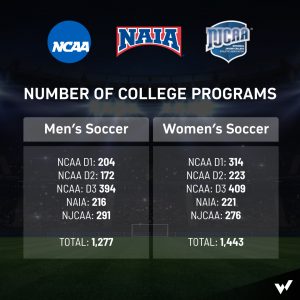The Reality of College Soccer Dreams: A Statistical Perspective for High School Players
Soccer a game that requires not only physical power but also strategic thinking and teamwork. For many high school students, the dream is to take their passion for soccer to the next level – college. But what are the odds of a high school soccer player competing in college? Let’s dive into the data to find out.
At a Glance
1. High School to College Transition Rates: In 2022, 8.0% of U.S. high school male soccer players and 10.6% of female players went on to compete at any college level. The odds of a U.S. high school soccer player making any college roster were 12:1 for males and 10:1 for females.
2. NCAA Division I Participation Odds: The odds of playing NCAA I soccer are considerably tougher for U.S. male players (108:1) compared to female players (41:1). This disparity is attributed to fewer Men’s D1 soccer teams, more high school male soccer players competing for college roster spots, and a higher percentage of foreign student-athletes on men’s teams. Notably, 37% of athletes on men’s Division I soccer teams are international students, compared to 11% on women’s teams.
3. College Soccer Landscape: In total, 1,744 U.S. colleges sponsor varsity soccer teams, with a breakdown as follows: NCAA I (350 schools – 212 men’s soccer and 348 women’s soccer), NCAA II (260 schools – 202 men’s soccer and 258 women’s soccer), NCAA III (441 schools – 414 men’s soccer and 432 women’s soccer), NAIA (212 schools – 207 men’s soccer and 210 women’s soccer), NJCAA (274 schools – 242 men’s soccer and 245 women’s soccer), CCCAA (95 schools – 78 men’s soccer and 93 women’s soccer), and other categories (112 schools – 104 men’s soccer and 84 women’s soccer). The total number of athletes playing college soccer is approximately 88,305, split almost evenly between men and women.
4. Scholarship Allocation: Soccer is considered an equivalency sport for NCAA limits, allowing partial scholarships. However, the average athletic scholarship only covers about 30% of a typical athlete’s annual college costs. Full scholarships in college soccer are rare, and the allocation varies significantly between divisions and schools. For instance, NCAA Division I men’s soccer teams have an average roster size of 32 but only a maximum of 9.9 athletic scholarships to award per team.
High School Soccer Players in the United States
In the 2022 school year, there were 454,324 male and 390,108 female high school soccer players in the United States.
College Soccer Players
Out of these high school players, 44,259 males and 44,046 females went on to play soccer in college.
Competing at Any College Level
When we look at the percentage of high school soccer players competing at any college level, we see that 8.0% of males and 10.6% of females make the cut.
Competing at NCAA I Schools
The competition gets even tougher when we consider the percentage of high school soccer players competing at NCAA I schools. Only 0.9% of males and 2.4% of females manage to secure a spot on an NCAA I roster.
Why Are the Odds of Making an NCAA Division I Roster Tougher for Male Players?
The odds of a US high school soccer player making an NCAA I roster are 108:1 for males and 41:1 for females. There are three primary reasons why the odds are tougher for US male players:
- There are almost 40% fewer Men’s D1 soccer teams (212) than Women’s teams (348).
- There are 16% more US high school male soccer players competing for college roster spots than female players.
- There is a significantly higher percentage of foreign student athletes playing Division I soccer on men’s teams (37%) than on Women’s teams (11%).
NCAA I vs NCAA III Rosters for Male Players
US male soccer players have about three times better odds of making an NCAA III roster over an NCAA I roster. This is because there are almost twice the number of D3 teams (414) versus D1 teams (212), and D3 rosters are composed of a much higher average percentage of US players than D1 teams.
How to Increase Your Chances to Play College Soccer
Standing out from the crowd is crucial when it comes to increasing your chances of playing college soccer. One way to do this is by creating a professional highlight video that showcases your skills, techniques, and understanding of the game. Coaches and recruiters often rely on these videos to assess a player’s abilities and potential.
Another way to stand out is by gaining international experience. Playing soccer in a different country can provide more professional-looking highlight videos and expose you to new styles of play, coaching methods, and cultures. All of these can enhance your game and make you a more attractive prospect to college coaches.
Conclusion
While the odds may seem daunting, with the correct coaching and a plan for recruitment, it’s still very possible for a US high school soccer player to make a college roster. These statistics highlight the competitive nature of the college soccer recruiting process, the significant role of international players, especially in men’s soccer, and the challenges associated with securing scholarships.

I am a German native based in the USA. As a former Bundesliga academy player in Germany and an NCAA soccer player at Hofstra University in New York and CSU in Los Angeles on a full scholarship, I have experienced the pros and cons of both cultures. Soccer/Football has changed my life in so many positive ways, and I am dedicated to sharing my experience with the next generation of players.





